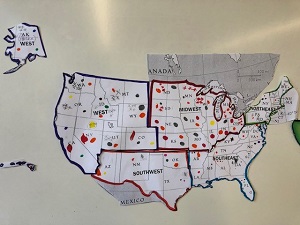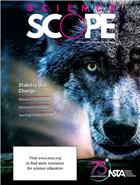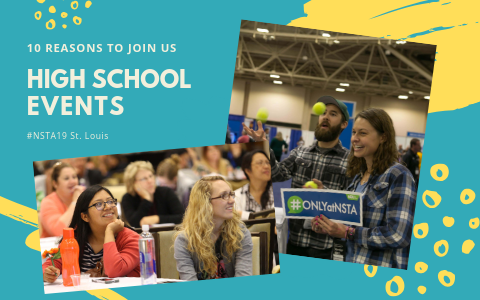
This week in education news, Senator Klobuchar is running for president; girls of color have a place in STEM; report finds that the teaching force has been greatly changing, but few have noticed; University of California system now allowing high school computer science courses will be counted toward the core curriculum credit; President Trump calls for new AI workforce-development efforts; Linda Darling-Hammond named new head of California State Board of Education; Tennessee governor proposes $4M for STEM education; Astronaut Mark Kelly is running for U.S. Senate; and report finds that homework tends to be aligned to state standards, but not all that rigorous.
Sen. Amy Klobuchar, a STEM Fan, Is Running for President
Sen. Amy Klobuchar, D-Minn., is the latest Democratic senator to announce her candidacy for the White House in 2020. We highlighted the Minnesota senior senator’s work on education issues late last year. Klobuchar, the daughter of an elementary school teacher, has worked to boost science, technology, engineering, and math (STEM) during her tenure in the Senate—she was first elected to her seat in 2006. Read the blog featured in Education Week.
A 17-Year-Old Wants to Spice Up Science Classes and, Eventually, Democratize Education
Steven Wang got into the tech field about seven years ago – as a pre-adolescent. Now, at 17, he has a startup that is on the verge of being acquired and a concrete vision for how he wants to use technology to transform the learning experience for students all over the world. Read the article featured in The Hechinger Report.
A Principal’s View: How Introducing STEM Has Radically Changed My Washington, D.C., School — and Just Won Us a Major Innovation Award
Some might not expect a school in southeast Washington, D.C., to have the only all-black robotics team at a national competition. Others might look at Hendley Elementary School’s Partnership for Assessment of Readiness for College and Careers (PARCC) scores and not assume that our students are coding, problem-solving, and engaging in critical thinking daily. Even I could have been discouraged when I saw that less than 10 percent of our fourth- and fifth-grade students participated in the annual school science fair when I started as principal. Instead, I was motivated by it. Read the article posted on The 74.
Richard Ingersoll: The Transformation of the Teaching Workforce
Internationally acclaimed researcher Richard Ingersoll discusses his new edition of Seven Trends: The Transformation of the Teaching Force, a landmark study examining 30 years of data on the teacher labor market. Ingersoll joins CPRE Director Jonathan Supovitz to highlight a number of key findings, including an ongoing “greening” of the workforce and an “unheralded victory” for minority recruitment initiatives. Listen to the discussion featured on CPRE.org.
University of California Now Allows High-School Computer Science as Core Curriculum Credit
The University of California system has announced it’s now allowing high school computer science courses to be counted toward the core curriculum prerequisites for admission to its nine universities around the state — an “acknowledgement that CS, much like the traditional science courses, has merits for students going through high school,” said Claire Shorall, a high school computer science teacher in the San Francisco Bay Area who has been advocating for the change. Read the article featured in EdScoop.
Trump Calls for New AI Workforce-Development Efforts, But Offers No New Money
President Donald Trump on Monday signed a new executive order directing federal agencies to focus their attention on artificial intelligence, including new workforce-preparation efforts that could reach down into K-12. Read the article featured in Education Week.
Gov. Newsom names new head of State Board of Education in California
In his first State of the State speech, Gov. Gavin Newsom named Linda Darling-Hammond, a Stanford University professor emeritus and one of the nation’s most prominent education researchers, to head California’s State Board of Education. Read the article featured in EdSource.
New Girl Scout Study Shows What Girls Are Doing to Gain Traction as Digital Leaders
Girl Scouts of the USA (GSUSA), the premier leadership development organization for girls, released Decoding the Digital Girl: Defining and Supporting Girls’ Digital Leadership. For the report, the Girl Scout Research Institute (GSRI) surveyed close to 2,900 girls and boys ages 5–17 and their parents to learn more about girls’ digital leadership, differences between girls’ and boys’ digital engagement, and the role of parents/caregivers in this domain. Read the press release.
Higher Ed is Pushing STEM Diversity, But is Change Happening Fast Enough?
Efforts to draw underrepresented students into science and tech fields are making progress, but a new report reveals more work is needed. Read the article featured in Education DIVE.
Gov. Bill Lee Proposes $4M for STEM Education, Creation of K-8 Computer Science Standards
Gov. Bill Lee is prioritizing STEM education in his legislative agenda, which proposes to boost opportunities for students statewide, including the creation of statewide K-8 computer science standards. This is Lee’s second education initiative tied to his legislative priorities and would create the Future Workforce Initiative focused on science, technology, engineering and mathematics. Read the article featured in the Nashville Tennessean.
Astronaut Mark Kelly Announces “Next Mission”: Running for U.S. Senate
Astronaut Mark Kelly is setting his eyes on a new frontier: the United States Senate. In a four-minute-long video, Kelly announced that his “next mission” is to run for Arizona’s Senate seat formerly occupied by the late Sen. John McCain. Read the article featured on CBSNews.com.
Is Homework Valuable or Not? Try Looking at Quality Instead
Homework is one those never-ending debates in K-12 circles that re-emerges every few years, bringing with it a new collection of headlines. Usually they bemoan how much homework students have, or highlight districts and even states that have sought to cap or eliminate homework. Now, a new analysis from the Center for American Progress suggests a more fruitful way of thinking about this problem. Maybe, it suggests, what we should be doing is looking at what students are routinely being asked to do in take-home assignments, how well that homework supports their learning goals (or doesn’t), and make changes from there. Read the article featured in Education Week.
The Two Codes Your Kids Need to Know
A few years ago, the leaders of the College Board, the folks who administer the SAT college entrance exam, asked themselves a radical question: Of all the skills and knowledge that we test young people for that we know are correlated with success in college and in life, which is the most important? Their answer: the ability to master “two codes” — computer science and the U.S. Constitution. Read the article featured in The New York Times.
Stay tuned for next week’s top education news stories.
The Communication, Legislative & Public Affairs (CLPA) team strives to keep NSTA members, teachers, science education leaders, and the general public informed about NSTA programs, products, and services and key science education issues and legislation. In the association’s role as the national voice for science education, its CLPA team actively promotes NSTA’s positions on science education issues and communicates key NSTA messages to essential audiences.
The mission of NSTA is to promote excellence and innovation in science teaching and learning for all.
Follow NSTA


 additional time that students need to observe, question, investigate, and interpret results. Thinking and learning takes time. Interdisciplinary instruction within my elementary classroom provides authentic, relevant learning experiences that support the NGSS and my state’s learning standards for Math, English Language Arts, Social Studies, and 21st Century Skills.
additional time that students need to observe, question, investigate, and interpret results. Thinking and learning takes time. Interdisciplinary instruction within my elementary classroom provides authentic, relevant learning experiences that support the NGSS and my state’s learning standards for Math, English Language Arts, Social Studies, and 21st Century Skills. discover the range of reasons for the existence of this market, students naturally start discussing laws that either encourage or discourage this practice.
discover the range of reasons for the existence of this market, students naturally start discussing laws that either encourage or discourage this practice.
































 I hope 20 years from now I can still get excited about being a part of kids’ lives. I am looking for suggestions on how to enjoy teaching for a long time. — J., Missouri
I hope 20 years from now I can still get excited about being a part of kids’ lives. I am looking for suggestions on how to enjoy teaching for a long time. — J., Missouri engineering solutions, they learn to create and evaluate arguments using evidence and logical reasoning. Through critical discourse, they are challenged to distinguish opinion from evidence. They learn that argumentation is how scientists collaboratively construct and revise scientific knowledge.”
engineering solutions, they learn to create and evaluate arguments using evidence and logical reasoning. Through critical discourse, they are challenged to distinguish opinion from evidence. They learn that argumentation is how scientists collaboratively construct and revise scientific knowledge.”






 A sensory play experience attracts different children depending on what material is provided. Just as some children are drawn to certain materials, others avoid them. “Children differ in their ability to process and respond to information from the environment while engaging in activities” (
A sensory play experience attracts different children depending on what material is provided. Just as some children are drawn to certain materials, others avoid them. “Children differ in their ability to process and respond to information from the environment while engaging in activities” (





